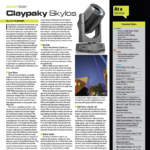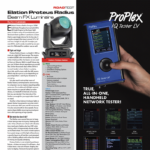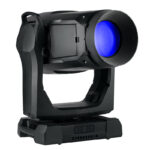Martin has built an affordable small console that can run with the big dogs. It has a dual core processor that runs on 4GB of RAM, making it faster than previous Martin consoles. The desk runs on the exact same software as Martin’s consoles. All shows utilizing the same software can be transferred from the M2GO to the M1 or Maxxyz series of desks. This console does not have a disk drive, but comes with a 32GB solid state drive. All show files and software upgrades are stored/transferred via a USB memory stick. I turn the console on and it boots up in less than a minute.
Compact Footprint
The first thing I look at is the face. This baby is tiny, but well-thought-out. The physical footprint is only 12 inches long by 21 inches wide, and a few inches tall. It weighs less than 10 pounds. I notice a frame made out of steel and aluminum. The top shell is made of scratch-resistant hard plastic; the face of the console is stealth gray in color. Quite handy when the house lights are out. A single LED lamp is adequate for a console light, and there is a dimmer wheel next to it. The previous Martin desks all came with separate intensity/color/ position/beam and gobo buttons. These buttons have been replaced by a small LCD touchscreen on the bottom corner of the desk. There are four large encoder wheels on the front. What they do is determined by whatever parameter or effect attribute you select on that LCD screen. These encoders have the same push function one has with the M1 console.
I notice the absence of a Grand Master fader. A single knob on the upper left side of the face has replaced it. Pressing down on the knob acts as a temporary black out button. Nifty space-saver for a function rarely used. There are 10 playback faders, but they are not small as one might expect. My fingers don’t bump into each other as I slam the faders back and forth, club-style. Every fader is connected to four separate buttons, each of which can be assigned a task by the programmer through the cue “options” window. For instance, one can become a “Go” button that executes the cue, while one can be made into a flash button to bump intensities on. The keypad and many of the buttons used for programming are the same size as any normal desk. There are eight customizable multi-function keys in a row at the top. These can be anything from view buttons to macros to cue executors.
I see no other LCD screens to tell me which fader or encoder wheel does what. But if I look up at the screen in front, I immediately see the usual setup one recognizes from the larger Martin consoles. The masterful Fade and Delay buttons that have made the range of Martin desks stand out amongst programmers are here, as are all the usual buttons one needs to program and manipulate show management. In the bottom center of the console are the big “Go” and “Back” buttons to activate the selected cue lists.
Ins and Outs
As I make my way around the console, I notice five USB outputs, four XLR DMX outputs and two etherCON connectors for Art-Net out and a remote network. On the side of the console, I notice two slots where optional MIDI and SMPTE modules have been installed. To keep the price down, Martin does not include these in the initial desk, giving the buyer the option of buying them or not. Very clever for targeting the needs of the young LD who wishes to own his own desk. There is a VGA as well as an HDMI connector on the back. One can utilize two external monitors, and they can both be touch screens if desired. The last thing I notice is the outboard power supply. The desk actually runs off of 12 volts DC. One doesn’t plug it into a wall. Then I look at the power switch and need to make an inquiry.
The power switch is actually a 3-way toggle. In the center position, the console is denied power input and is off. Then one can either throw the switch to the left, where it’s labeled “USB,” or to the right, where it says “CPU.” By just turning on the USB power, the CPU in the desk becomes inactive, and the console can now be used as an external 10-fader playback wing with any of the other series of these desks. The user could also connect it to an existing M-PC setup as a programmer wing and then have access to 64 universes of DMX. I could also use this desk as a tracking backup of another console.
Two Versions
Martin has decided to utilize this same exact hardware/shell to be used without a brain of its own. Think of it as the baby brother, the M2PC. Basically, Martin sells this same desk but without the CPU. The desk attaches to your own laptop, which does the processing. It can also be used as a playback wing with any M series console. Of course, this is less expensive and is considered a separate product.
The console has an internal keyboard, but no mouse. One can attach their own (including a track ball mouse for focus) via the USB ports. There is no attached monitor. I find I need one large touchscreen monitor. I also recommend adding a cheap VGA monitor as well, to view cue lists during show playback. Martin doesn’t offer a flight case. That’s because one could simply pack this baby in their roller board suitcase and carry it on the plane. I did see where my friend had bought a hard plastic, foam lined “Seahorse” case for about $100. It weighed all of 10 pounds and contained a space for his console and touch screen monitor.
Child’s Play
Software-wise, I always refer to the Martin range of console as my Mattel consoles. It’s because they are the simplest desks to run in the world. Everything about the programming of the console is so easy compared to the competitors. While there is a help menu embedded in the desk, I only had to refer to it once while messing around. The EFX engine works well and has been sped up considerably with the release of the latest software. They have recently added a “multiplier” function to the EFX software, making it easier to program many LED channels. The console only has four XLR outs, but users can expand to a maximum of eight universes of DMX with the addition of the M2GO expansion pack.
The console doesn’t care if you assign some universes to the XLR outputs and some through Art-Net at the same time. One can also adjust an XLR output to act as a “DMX Input,” accepting commands from an outside console with more faders. Of course, when the user does this, he loses a DMX output temporarily. Martin has a device named the USB Duo DMX; it can spit out two universes at a time. Or the user could simply use one of Martin’s Ether2DMX8 boxes that connect directly to the Art-Net port. One could even merge another M2GO desk with this one and have both consoles send DMX down the Ethernet line.
All in all, I consider this product to be extremely well-thought-out and a money saver for almost any occasion. Lighting designers who work in different rooms each night can carry their own console and not be at anyone’s mercy. Need a console you can shove on a shelf in a closet of a trade show? Look no further. Its utilization as a backup console makes it a no-brainer. The bottom line is, I have zero complaints about this product.
Martin M2GO/M2PC
- What They Are: Ultra-portable lighting control solutions; either free-standing (M2GO) or used with a a laptop or as a playback wing (M2PC).
- Pros: Big plus for LDs who want to carry their own console.
- Cons: I have zero complaints about these products.
- How Much: MSRP: M2GO, $8,750; M2PC, $4,999.



